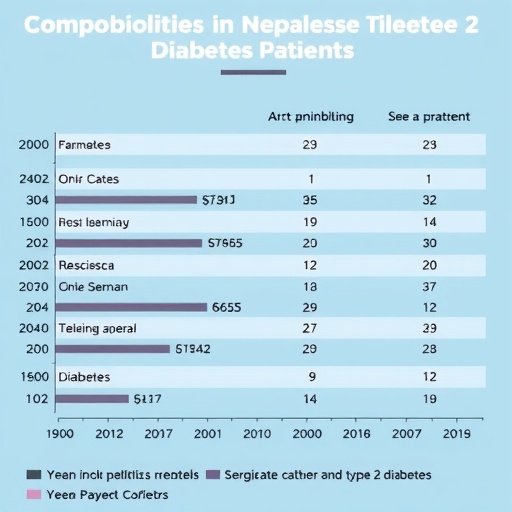In a significant study focused on the public health challenges of Nepal, researchers have thoroughly investigated the prevalence and determinants of comorbidities in patients diagnosed with type 2 diabetes mellitus (T2DM). The findings are particularly compelling, presenting an urgent call for attention to the complex medical landscapes that many individuals navigate, especially in developing countries. Given the growing burden of diabetes globally, understanding its associated complications is critical not only for patient care but also for informing healthcare policy and resource allocation.
Diabetes is often not an isolated condition; it frequently occurs alongside other health issues, which are referred to as comorbidities. The presence of comorbidities can complicate diabetes management and lead to poorer health outcomes, increased healthcare costs, and diminished quality of life. The study conducted by Chaurasia, Mothashin, and Hossain shines a light on this reality, specifically within a Nepalese context where healthcare resources may be more limited.
The investigation was meticulously designed to be cross-sectional, allowing the research team to assess a snapshot of diabetic patients at one point in time. This approach is beneficial in identifying prevalent comorbidities within the population, as well as factors that may contribute to their occurrence. By gathering and analyzing data from a diverse group of individuals diagnosed with T2DM, the researchers were able to paint a comprehensive picture of the interrelated health conditions that exist within this demographic.
One of the study’s key findings revealed that the prevalence of comorbidities among the sampled diabetic patients was startlingly high. The authors documented conditions such as hypertension, dyslipidemia, and obesity, all of which are commonly associated with diabetes. The convergence of these ailments exacerbates the treatment and management of diabetes, presenting a multifaceted challenge for both patients and healthcare providers.
Moreover, the researchers explored various determinants that played a role in the development of these comorbidities. Factors such as age, duration of diabetes, the presence of family history of diabetes, and lifestyle choices significantly influenced the likelihood of encountering additional health issues. The correlation between lifestyle choices—like diet, physical activity, and smoking habits—and the emergence of comorbidities underscores the necessity for comprehensive health education and preventive measures within affected populations.
The findings also suggest that socioeconomic status is a crucial determinant in the prevalence of comorbidities among diabetic patients in Nepal. Individuals from lower economic backgrounds may have less access to resources such as nutritious foods, healthcare services, and educational opportunities. This disparity not only influences individual health outcomes but also amplifies the public health burden as a whole.
In examining the evidence, it becomes clear that there is a pressing need for improved healthcare strategies focused on screening and managing comorbidities in diabetic patients. Health practitioners must adopt a holistic approach that addresses not only the primary condition of diabetes but also the risk factors and associated conditions that patients may face. This approach will require coordinated efforts among healthcare professionals, patients, and policymakers to establish effective treatment plans and preventive measures.
Additionally, the implications of this study extend beyond the confines of medical treatment. It is vital for public health campaigns to emphasize the importance of regular health check-ups, lifestyle modifications, and community health initiatives aimed at diabetes prevention and management. Community engagement can empower individuals and families to take proactive steps toward their health, potentially reducing the incidence of diabetes and its complicating comorbidities.
In summary, the research conducted by Chaurasia and colleagues serves as an essential contribution to the scientific understanding of diabetes and its comorbidities, particularly in the context of a developing nation like Nepal. The intricate relationships among various health conditions prompt a reassessment of how diabetes is treated and managed in the healthcare system. The study’s insights lay the groundwork for future research and intervention efforts aimed at alleviating the burden of diabetes and improving the health outcomes of those affected.
As the healthcare community continues to grapple with the effects of chronic diseases, it becomes increasingly apparent that collaborative efforts are needed to tackle the multifactorial nature of diabetes and its related health issues. The study ultimately calls for action to bridge gaps in healthcare delivery and improve the quality of life for individuals living with T2DM in Nepal and beyond.
In conclusion, this comprehensive examination of the prevalence and determinants of comorbidities in type 2 diabetes patients highlights an urgent need for targeted health strategies and preventive measures to address this growing public health challenge. By focusing on the interrelated factors that contribute to comorbid conditions, healthcare systems can develop more effective treatments and support systems for those living with diabetes.
Subject of Research: Prevalence and determinants of comorbidities among patients with type 2 diabetes mellitus in Nepal.
Article Title: Prevalence and determinants of comorbidities among patients with type 2 diabetes mellitus in Nepal: a cross-sectional study.
Article References: Chaurasia, N.K., Mothashin, M. & Hossain, M.G. Prevalence and determinants of comorbidities among patients with type 2 diabetes mellitus in Nepal: a cross-sectional study.
BMC Endocr Disord 25, 247 (2025). https://doi.org/10.1186/s12902-025-02068-y
Image Credits: AI Generated
DOI: https://doi.org/10.1186/s12902-025-02068-y
Keywords: Diabetes, comorbidities, prevalence, Nepal, public health.




